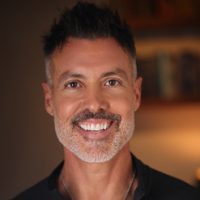
When I first came out to my mom, her response to me was, “You know what my religion says: I can hate the sin, but love the sinner.”
It was during the middle of winter and I was sitting in the passenger seat of her car. We had just eaten dinner at a nearby restaurant and I was planning on coming out to her after we finished our meal. I asked if she wanted to take a walk outside because I was afraid her reaction might cause a scene inside of the restaurant. When I asked her to go for a walk, I remember her saying, “Chris, it’s ice-cold outside; we’ll freeze our butts off!” So, we went to her car instead.
It didn’t matter whether we were inside the warmth of her car or not; hearing her reaction and seeing the sudden distance in the expression on her face felt just as ice-cold as standing outside in the 48-degree winter weather.
I grew up in a religious household and so as a child. I was taught about heaven, hell, and what it meant “to be a sinner.” I also knew that I was gay from the age of six, so hiding my identity became my biggest priority growing up. Keeping my sexuality hidden was the number one most important thing I could do to prevent anyone from finding out and risk going to hell.
Unfortunately, misguided beliefs about people who are lesbian, gay, bisexual, transgender, or queer (LGBTQ) continue to negatively affect LGBTQ youth every day. Just this week, three friends have shared with me instances of queerphobia (the explicit or implicit hostile beliefs about LGBTQ people) that they’ve experienced in their workplace. All three are in helping professions—one, who works with youth in recovery, said that one of the lead therapists where he works asked him if he could help one of her male clients “speak more manly.” Not only is her comment rooted in heteronormativity, but it’s also harmful and homophobic. As a therapist, unconditional positive regard for her client should be the primary objective for strengthening the therapeutic alliance. Anti-LGBTQ bias won’t help this young man’s recovery.
Another, who works at a Catholic grade school, told me that the principal often expresses his discontent for youth who come out as LGBTQ. He thinks that youth today are “getting brainwashed.” And earlier this week, a friend, who is Clinical Director at an outpatient treatment facility for youth, called me to let me know that they’ve had some recent homophobic bullying on campus that they’d like to address. She asked if I could speak at one of their upcoming assemblies to share my coming out story and talk about anti-LGBTQ bullying.
Whether or not we grew up with religion, our lives have been influenced by religious beliefs. The United States was founded on Puritan values that still course through the veins of many North Americans today. Part of unlearning a thought system based on fear is by reexamining our beliefs, especially as they pertain to outdated and misinterpreted religious concepts that continue to create harm in the lives of LGBTQ youth or any human being. Until we live in a world where the message to young people that being LGBTQ isn’t something to fear, LGBTQ youth may experience increased challenges accepting themselves. One of my hopes for my newly released book, Raising LGBTQ Allies, is to help make having an LGBTQ child or knowing one something to revere.
Most of the parents I know who have a child who is LGBTQ initially questioned why their child is lesbian, gay, bisexual, transgender, or queer. Even the most accepting parents I know once thought there must be a reason or cause for their child’s gender or sexual identity. Some still question whether it was something they did or didn’t do. I don’t think I’ve ever heard a parent question why their child is straight or cisgender (when a person’s gender identity matches the sex they were assigned at birth.) If we explore what’s behind the curiosity about why a child is LGBTQ, we often find misguided beliefs about gender and sexual minorities. By digging deep, naming, and cleaning out our consciousness of harmful stigmas, we take their power away.
I recently read an article by a lesbian woman that speaks specifically to why it’s so important to join together to recognize our biases and talk openly about homophobia, transphobia, and bullying. The author, Diane Eller-Boyko, wrote, “Without models that affirm one’s self-image and love potential, there is pathology. The pathology I had to heal from was homophobia, not homosexuality.” Remnants of misguided religious beliefs about gender and sexuality still negatively affect modern belief systems, thereby influencing how we parent and subconsciously perceive LGBTQ youth.
We are touched by our history—which includes everything from pop culture, food, and trends to psychology, language, religion, and belief systems. Although we can’t change some people’s misguided beliefs, LGBTQ people can continue sharing our experience, strength, and hope to help shift limited generational ideology and challenge systemic cultural and religious queerphobia.
It’s said that in nature, the antidote grows next to the poison. Exploring our misguided beliefs about gender and sexuality is what will help us prevent homophobia, transphobia, and bullying. It will also help us to raise LGBTQ allies and change the narrative future generations will tell.
~










Read 12 comments and reply